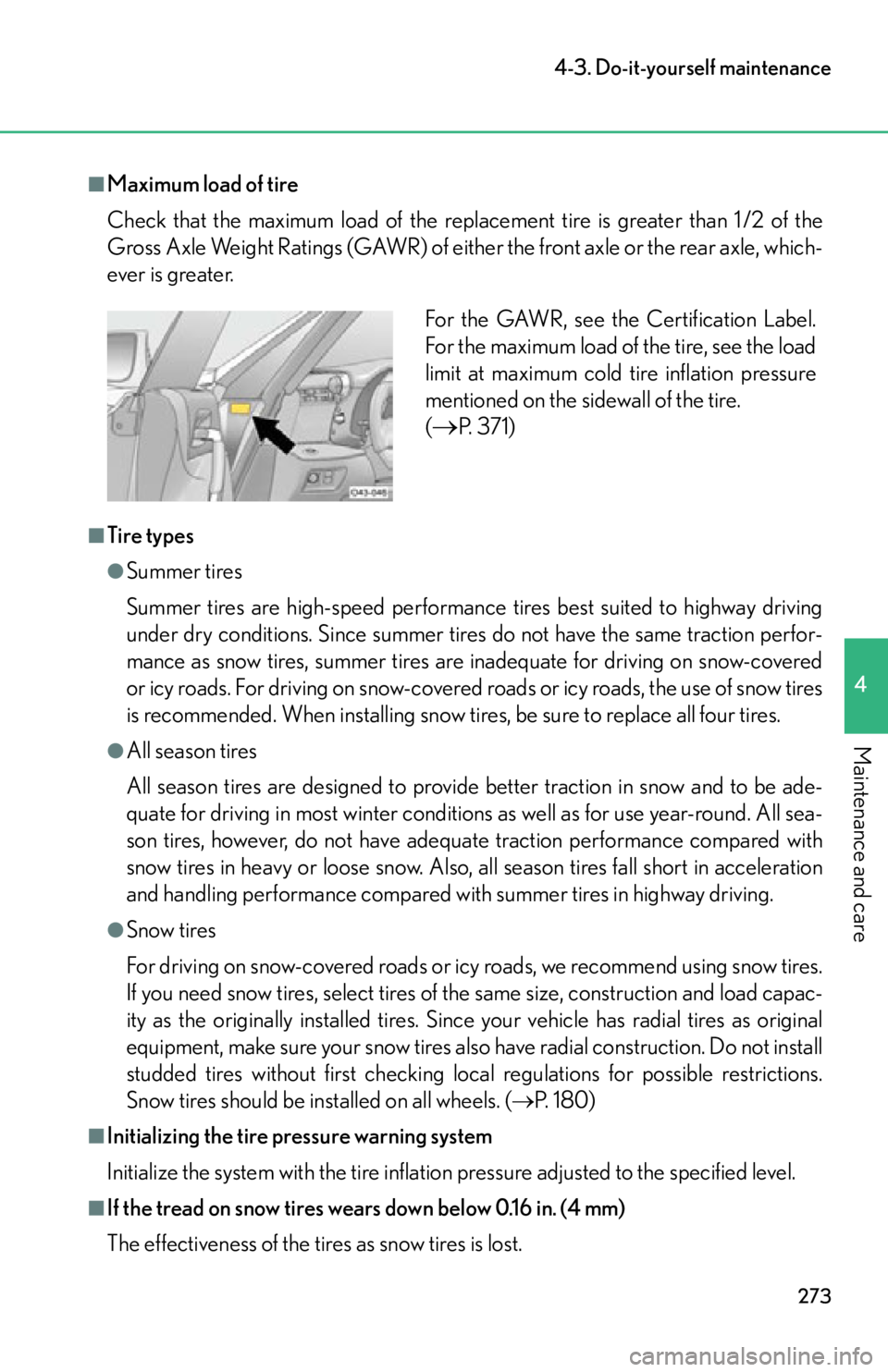Page 229 of 420

Maintenance and care4
227
4-1. Maintenance and careCleaning and protecting the vehicle exterior............ 228
Cleaning and protecting the vehicle interior .............. 235
4-2. Maintenance Maintenance requirements ........................ 240
General maintenance .......... 242
Emission inspection and maintenance (I/M)
programs................................ 246 4-3. Do-it-yourself
maintenance
Do-it-yourself service precautions ............................ 247
Hood .......................................... 250
Positioning a floor jack ......... 253
Engine compartment ........... 256
Adding washer fluid .............. 264
Battery ...................................... 265
Tires............................................ 270
Tire inflation pressure............ 277
Wheels ....................................... 281
Air conditioning filter ........... 283
Wireless remote control battery .................................... 285
Checking and replacing fuses ........................................ 287
Light bulbs ................................ 299
Page 230 of 420

228
4-1.Maintenance and care
Cleaning and protecting the vehicle exterior
Perform the following to protect the vehicle and maintain it in prime condi-
tion.
Standard Colors and Special Selection Colors (except Matte Black)
● Working from top to bottom, liber ally apply water to the vehicle
body, wheel wells and underside of the vehicle to remove any dirt
and dust.
● Wash the vehicle body using a sponge or soft cloth, such as a cham-
ois.
● For hard-to-remove marks, use ca r wash soap and rinse thoroughly
with water.
● Wipe away any water.
● Wax the vehicle when the waterproof coating deteriorates.
If water does not bead on a clean surface, apply wax when the vehicle
body is cool.
Matte Black (Special Selection Color)
●Working from top to bottom, liber ally apply water to the vehicle
body, wheel wells and underside of the vehicle to remove any dirt
and dust.
● Wash the vehicle body using a sponge or soft cloth, such as a cham-
ois.
● For hard-to-remove marks, use a neutral detergent and rinse thor-
oughly with water.
● Wipe away any water.
● Never use wax or abrasive compounds.
Page 231 of 420

229
4-1. Maintenance and care
4
Maintenance and care
■Automatic car washes
Do not use automatic car washes as they may scratch the vehicle body and damage
the paint.
■High pressure car washes
●Do not allow the nozzles of the car wash to come within close proximity of the
windows or rear hatch.
●Before car wash, check that the fuel filler door on your vehicle is closed prop-
erly.
■Aluminum wheels
●Remove any dirt immediately by using a neutral detergent. Do not use hard
brushes or abrasive cleaners. Do not use strong or harsh chemical cleaners.
Use the same mild detergent and wax as used on the paint.
●Do not use detergent on the wheels when they are hot, for example after driving
for long distance in the hot weather.
●Wash detergent from the wheels immediately after use.
■Cleaning the rear quarter glass
As the rear quarter glasses are made of polycarbonate, follow the procedure
below.
Remove dust and dirt on the surface with plenty of water.
Clean the surface using a mild soap or neutral detergent.
Rinse it with adequate water.
■Cleaner precaution
Do not use abrasive cleaners.
■Outside rear view mirror rain-clearing coating
Observe the following precautions in order to retain the rain-clearing properties of
the mirrors:
●Clean the mirrors using a car shampoo or glass cleaner that does not contain
silicone or an abrasive compound, and rinse thoroughly with water.
●Allow the mirrors to be exposed to direct sunlight for 1 to 2 days.
STEP1
STEP2
STEP3
Page 233 of 420

231
4-1. Maintenance and care
4
Maintenance and care
NOTICE
■Application of coatings to the vehicle body
Do not apply any kind of coating to the vehicle body as doing so may damage the
paint or reduce its durability.
■To prevent paint deterioration and corrosion on the body and components (alu-
minum wheels etc.)
Observe the following precautions:
●Wash the vehicle immediately in the following cases:
• After driving near the sea coast
• After driving on salted roads
• If coal tar or tree sap is present on the paint surface
• If dead insects, insect droppings or bird droppings are present on the paint
surface
• After driving in an area contaminated with soot, oily smoke, mine dust, iron
powder or chemical substances
• If the vehicle becomes heavily soiled with dust or mud
• If liquids such as benzene and gasoline are spilled on the paint surface
●If the paint is chipped or scratched, have it repaired immediately.
●To prevent the wheels from corroding, remove any dirt and store in a place with
low humidity when storing the wheels.
For the Matte Black, pay attent ion to the following as well:
●If anything is spilled on a painted surface, wipe it off as soon as possible.
If spilled washer fluid or alkaline fluids are left as is, the paint in the affected area
may deteriorate, causing blemishing.
●Do not wax or apply coating to the vehicle.
Doing so may cause a change in the body surface's texture or irregularities in the
paint.
Page 246 of 420
244
4-2. Maintenance
Vehicle exterior
Seats• Do the seat controls operate prop-
erly?
Steering wheel • Does the steering wheel rotate
smoothly?
• Does the steering wheel have the
correct amount of free play?
• There should not be any strange sounds coming from the steering
wheel.
ItemsCheck points
Doors • Do the doors operate smoothly?
Engine hood • Does the engine hood lock system
work properly?
Fluid leaks • There should not be any signs of
fluid leakage after the vehicle has
been parked.
Ti r e s • Is the tire inflation pressure cor-
rect?
• The tires should not be damaged or excessively worn.
• The wheel bolts should not be loose.
Wa s h e r f l u i d • Is there sufficient washer fluid?
( P. 2 6 4 )
ItemsCheck points
Page 272 of 420
270
4-3. Do-it-yourself maintenance
Tires
Replace tires when the treadwear indicators show.
■Checking tires
New tread
Treadwear indicator
Worn tread
The location of treadwear indica-
tors is shown by the “TWI” or “”
marks, etc., molded on the sidewall
of each tire.
■ The tire pressure warning system
Your vehicle is equipped with a tire pressure warning system that uses
tire pressure warning valves and tr ansmitters to detect low tire inflation
pressure before serious problems arise. ( P. 315)
Installing tire pressure warning valves and transmitters
When replacing tires or wheels, tire pressure warning valves and trans-
mitters must also be installed.
When new tire pressure warning va lves and transmitters are installed,
new ID codes must be registered in the tire pressure warning computer
and tire pressure warning system must be initialized. Have tire pressure
warning valve and transmitter ID codes registered by your Lexus dealer.
( P. 272)
Page 274 of 420

272
4-3. Do-it-yourself maintenance
Registering ID codesThe tire pressure warning valve and transmitter is equipped with a unique
ID code. When replacing a tire pressu re warning valve and transmitter, it
is necessary to register the ID code. Ha ve the ID code registered by your
Lexus dealer.
■When to replace your vehicle’s tires
Tires should be replaced if:
●You have tire damage such as cuts, splits, cracks deep enough to expose the
fabric or bulges indicating internal damage
●A tire goes flat repeatedly or cannot be properly repaired due to the size or
location of a cut or other damage
If you are not sure, consult with your Lexus dealer.
■Replacing tires and wheels
If the ID code of the tire pressure warning valve and transmitter is not registered,
the tire pressure warning system will not work properly. After driving for about 20
minutes, the tire pressure warning light fl ashes for 1 minute to indicate a system mal-
function.
■Tire life
Any tire over 6 years old must be checked by a qualified technician even if they
have seldom or never been used or damage is not obvious.
■Routine tire inflation pressure checks
The tire pressure warning system does not replace routine tire inflation pressure
checks. Make sure to check tire inflation pressure as part of your routine of daily
vehicle checks.
■Tire rotation
It is not possible to rotate the tires, as each tire is designed only for its original posi-
tion on the vehicle.
Page 275 of 420

273
4-3. Do-it-yourself maintenance
4
Maintenance and care
■Maximum load of tire
Check that the maximum load of the replacement tire is greater than 1 /2 of the
Gross Axle Weight Ratings (GAWR) of either the front axle or the rear axle, which-
ever is greater.
■Tire types
●Summer tires
Summer tires are high-speed performance tires best suited to highway driving
under dry conditions. Since summer tires do not have the same traction perfor-
mance as snow tires, summer tires are inadequate for driving on snow-covered
or icy roads. For driving on snow-covered roads or icy roads, the use of snow tires
is recommended. When installing snow tires, be sure to replace all four tires.
●All season tires
All season tires are designed to provide better traction in snow and to be ade-
quate for driving in most winter conditions as well as for use year-round. All sea-
son tires, however, do not have adequate traction performance compared with
snow tires in heavy or loose snow. Also, al l season tires fall short in acceleration
and handling performance compared with summer tires in highway driving.
●Snow tires
For driving on snow-covered roads or ic y roads, we recommend using snow tires.
If you need snow tires, select tires of the same size, construction and load capac-
ity as the originally installed tires. Since your vehicle has radial tires as original
equipment, make sure your snow tires also have radial construction. Do not install
studded tires without first checking local regulations for possible restrictions.
Snow tires should be installed on all wheels. ( P. 1 8 0 )
■Initializing the tire pressure warning system
Initialize the system with the tire inflatio n pressure adjusted to the specified level.
■If the tread on snow tires wears down below 0.16 in. (4 mm)
The effectiveness of the tires as snow tires is lost.
For the GAWR, see the Certification Label.
For the maximum load of the tire, see the load
limit at maximum cold tire inflation pressure
mentioned on the sidewall of the tire.
(
P. 3 7 1 )